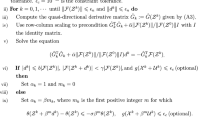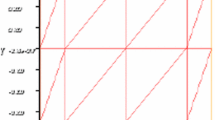Abstract
In this paper, we apply the local discontinuous Galerkin (LDG) method to 2D Keller–Segel (KS) chemotaxis model. We improve the results upon (Epshteyn and Kurganov in SIAM J Numer Anal, 47:368–408, 2008) and give optimal rate of convergence under special finite element spaces before the blow-up occurs (the exact solutions are smooth). Moreover, to construct physically relevant numerical approximations, we consider \(P^1\) LDG scheme and develop a positivity-preserving limiter to the scheme, extending the idea in Zhang and Shu (J Comput Phys, 229:8918–8934, 2010). With this limiter, we can prove the \(L^1\)-stability of the numerical scheme. Numerical experiments are performed to demonstrate the good performance of the positivity-preserving LDG scheme. Moreover, it is known that the chemotaxis model will yield blow-up solutions under certain initial conditions. We numerically demonstrate how to find the approximate blow-up time by using the \(L^2\)-norm of the \(L^1\)-stable numerical solution.



Similar content being viewed by others
References
Bassi, F., Rebay, S.: A high-order accurate discontinuous finite element method for the numerical solution of the compressible Navier-Stokes equations. J. Comput. Phys. 131, 267–279 (1997)
Chertock, A., Kurganov, A.: A second-order positivity preserving central-upwind scheme for chemotaxis and haptotaxis models. Numer. Math. 111, 169–205 (2008)
Childress, S., Percus, J.: Nonlinear aspects of chemotaxis. Math. Biosci. 56, 217–237 (1981)
Ciarlet, P.: Finite Element Method for Elliptic Problems. North-Holland, Amsterdam (1978)
Cockburn, B., Dong, B.: An analysis of the minimal dissipation local discontinuous Galerkin method for convection-diffusion problems. J. Sci. Comput. 32, 233–262 (2007)
Cockburn, B., Hou, S., Shu, C.-W.: The Runge-Kutta local projection discontinuous Galerkin finite element method for conservation laws IV: the multidimensional case. Math. Comput. 54, 545–581 (1990)
Cockburn, B., Kanschat, G., Perugia, I., Schotzau, D.: Superconvergence of the local discontinuous Galerkin method for elliptic problems on cartesian grids. SIAM J. Numer. Anal. 39, 264–285 (2001)
Cockburn, B., Lin, S.-Y., Shu, C.-W.: TVB Runge-Kutta local projection discontinuous Galerkin finite element method for conservation laws III: one-dimensional systems. J. Comput. Phys. 84, 90–113 (1989)
Cockburn, B., Shu, C.-W.: TVB Runge-Kutta local projection discontinuous Galerkin finite element method for conservation laws II: general framework. Math. Comput. 52, 411–435 (1989)
Cockburn, B., Shu, C.-W.: The Runge-Kutta discontinuous Galerkin method for conservation laws V: multidimensional systems. J. Comput. Phys. 141, 199–224 (1998)
Cockburn, B., Shu, C.-W.: The local discontinuous Galerkin method for time dependent convection-diffusion systems. SIAM J. Numer. Anal. 35, 2440–2463 (1998)
Epshteyn, Y.: Discontinuous Galerkin methods for the chemotaxis and haptotaxis models. J. Comput. Appl. Math. 224, 168–181 (2009)
Epshteyn, Y.: Upwind-difference potentials method for Patlak-Keller-Segel chemotaxis model. J. Sci. Comput. 53, 689–713 (2012)
Epshteyn, Y., Izmirlioglu, A.: Fully discrete analysis of a discontinuous finite element method for the Keller-Segel Chemotaxis model. J. Sci. Comput. 40, 211–256 (2009)
Epshteyn, Y., Kurganov, A.: New interior penalty discontinuous Galerkin methods for the Keller-Segel Chemotaxis model. SIAM J. Numer. Anal. 47, 368–408 (2008)
Fatkullin, I.: A study of blow-ups in the Keller-Segel model of chemotaxis. Nonlinearity 26, 81–94 (2013)
Filbet, F.: A finite volume scheme for the Patlak-Keller-Segel chemotaxis model. Numer. Math. 104, 457–488 (2006)
Gajewski, H., Zacharias, K.: Global behaviour of a reaction-diffusion system modelling chemotaxis. Math. Nachr. 195, 77–114 (1998)
Gelfand, I.M.: Some questions of analysis and differential equations. Am. Math. Soc. Transl. 26, 201–219 (1963)
Gottlieb, S., Shu, C.-W., Tadmor, E.: Strong stability-preserving high-order time discretization methods. SIAM Rev. 43, 89–112 (2001)
Guo, L., Yang, Y.: Positivity-preserving high-order local discontinuous Galerkin method for parabolic equations with blow-up solutions. J. Comput. Phys. 289, 181–195 (2015)
Hakovec, J., Schmeiser, C.: Stochastic particle approximation for measure valued solutions of the 2d Keller-Segel system. J. Stat. Phys. 135, 133–151 (2009)
Herrero, M.A., Medina, E., Velázquez, J.J.L.: Finite-time aggregation into a single point in a reaction-diffusion system. Nonlinearity 10, 1739–1754 (1997)
Herrero, M.A., Velazquez, J.J.L.: Singularity patterns in a chemotaxis model. Math. Annu. 306, 583–623 (1996)
Horstman, D.: From 1970 until now: The Keller-Segel model in chemotaxis and its consequences I. Jahresber. DMV 105(2003), 103–165 (1970)
Horstmann, D.: From 1970 until now: The Keller-Segel model in chemotaxis and its consequences II. Jahresber. DMV 106(2004), 51–69 (1970)
Hurd, A.E., Sattinger, D.H.: Questions of existence and uniqueness for hyperbolic equations with discontinuous coefficients. Trans. Am. Math. Soc. 132, 159–174 (1968)
Keller, E.F., Segel, L.A.: Initiation on slime mold aggregation viewed as instability. J. Theor. Biol. 26, 399–415 (1970)
Marrocco, A.: 2D simulation of chemotaxis bacteria aggregation. ESAIM Math. Model. Numer. Anal. 37, 617–630 (2003)
Meng, X., Shu, C.-W., Zhang, Q., Wu, B.: Superconvergence of discontinuous Galerkin methods for scalar nonlinear conservation laws in one space dimension. SIAM J. Numer. Anal. 50, 2336–2356 (2012)
Nagai, T.: Blow-up of radially symmetric solutions to a chemotaxis system. Adv. Math. Sci. Appl. 3, 581–601 (1995)
Nakaguchi, E., Yagi, Y.: Fully discrete approximation by Galerkin Runge-Kutta methods for quasilinear parabolic systems. Hokkaido Math. J. 31, 385–429 (2002)
Patlak, C.: Random walk with persistence and external bias. Bull. Math. Biophys. 15, 311–338 (1953)
Qin, T., Shu, C.-W., Yang, Y.: Bound-preserving discontinuous Galerkin methods for relativistic hydrodynamics. J. Comput. Phys. 315, 323–347 (2016)
Reed, W.H., Hill, T.R.: Triangular mesh methods for the Neutron transport equation. Los Alamos Scientific Laboratory Report LA-UR-73-479. Los Alamos, NM (1973)
Saito, N.: Conservative upwind finite-element method for a simplified Keller-Segel system modelling chemotaxis. IMA J. Numer. Anal. 27, 332–365 (2007)
Saito, N.: Error analysis of a conservative finite-element approximation for the Keller-Segel system of chemotaxis. Commun. Pure Appl. Anal. 11, 339–364 (2012)
Shu, C.-W.: Total-variation-diminishing time discretizations. SIAM J. Sci. Stat. Comput. 9, 1073–1084 (1988)
Shu, C.-W., Osher, S.: Efficient implementation of essentially non-oscillatory shock-capturing schemes. J. Comput. Phys. 77, 439–471 (1988)
Strehl, R., Sokolov, A., Kuzmin, D., Horstmann, D., Turek, S.: A positivity-preserving finite element method for chemotaxis problems in 3D. J. Comput. Appl. Math. 239, 290–303 (2013)
Tyson, R., Stern, L.J., LeVeque, R.J.: Fractional step methods applied to a chemotaxis model. J. Math. Biol. 41, 455–475 (2000)
Wang, H., Shu, C.-W., Zhang, Q.: Stability and error estimates of local discontinuous Galerkin methods with implicit-explicit time-marching for advection-diffusion problems. SIAM J. Numer. Anal. 53, 206–227 (2015)
Wang, H., Wang, S., Shu, C.-W., Zhang, Q.: Local discontinuous Galerkin methods with implicit-explicit time-marching for multi-dimensional convection-diffusion problems. ESAIM Math. Model. Numer. Anal. 50, 1083–1105 (2016)
Yang, Y., Shu, C.-W.: Discontinuous Galerkin method for hyperbolic equations involving \(\delta \)-singularities: negative-order norm error estimates and applications. Numer. Math. 124, 753–781 (2013)
Yang, Y., Wei, D., Shu, C.-W.: Discontinuous Galerkin method for Krause’s consensus models and pressureless Euler equations. J. Comput. Phys. 252, 109–127 (2013)
Zhang, Q., Shu, C.-W.: Error estimates to smooth solutions of Runge-Kutta discontinuous Galerkin methods for scalar conservation laws. SIAM J. Numer. Anal. 42, 641–666 (2004)
Zhang, Q., Shu, C.-W.: Stability analysis and a priori error estimates to the third order explicit Runge-Kutta discontinuous Galerkin method for scalar conservation laws. SIAM J. Numer. Anal. 48, 1038–1063 (2010)
Zhang, X., Shu, C.-W.: On maximum-principle-satisfying high order schemes for scalar conservation laws. J. Comput. Phys. 229, 3091–3120 (2010)
Zhang, X., Shu, C.-W.: On positivity-preserving high order discontinuous Galerkin schemes for compressible Euler equations on rectangular meshes. J. Comput. Phys. 229, 8918–8934 (2010)
Zhang, X., Shu, C.-W.: Positivity-preserving high order discontinuous Galerkin schemes for compressible Euler equations with source terms. J. Comput. Phys. 230, 1238–1248 (2011)
Zhang, Y., Zhang, X., Shu, C.-W.: Maximum-principle-satisfying second order discontinuous Galerkin schemes for convection-diffusion equations on triangular meshes. J. Comput. Phys. 234, 295–316 (2013)
Zhao, X., Yang, Y., Syler, C.: A positivity-preserving semi-implicit discontinuous Galerkin scheme for solving extended magnetohydrodynamics equations. J. Comput. Phys. 278, 400–415 (2014)
Acknowledgements
Xingjie Helen Li would like to thank the Shanghai Centre for Mathematics Science (SCMS), Fudan University, for support during her visit.
Author information
Authors and Affiliations
Corresponding author
Additional information
Research supported by ARO Grant W911NF-15-1-0226, NSF Grant DMS-1418750, China National Natural Science Foundation (11571367 and 11601536), Michigan Technological University, Research Excellence Fund Scholarship and Creativity Grant.
Rights and permissions
About this article
Cite this article
Li, X.H., Shu, CW. & Yang, Y. Local Discontinuous Galerkin Method for the Keller-Segel Chemotaxis Model. J Sci Comput 73, 943–967 (2017). https://doi.org/10.1007/s10915-016-0354-y
Received:
Revised:
Accepted:
Published:
Issue Date:
DOI: https://doi.org/10.1007/s10915-016-0354-y




